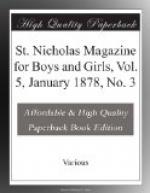[Illustration: POURING THE MELTED GOLD INTO THE MOLDS.]
“This press,” says the usher, “is cutting double-eagles; and in the single moment, by the watch, that we have been looking at it, it has cut forty-five hundred dollars’ worth. The same number of cuts would make only two dollars and twenty cents if made in copper.”
The machine goes on hastily biting out the round planchets to the end of the ribbon, and then the guide holds up the long strip full of holes, much as you have seen the dough after the cook has cut out her ginger-snaps. These perforated bars go back to the furnace to be melted over.
“The planchets,” says the guide, “after being annealed in those furnaces which you see at the rear of the room, are taken upstairs and most carefully weighed.”
None but women are employed in the weighing-room, and so delicate are the scales that they will move with the weight of a hair. If a planchet is found too light, it is thrown aside to be remelted; if only slightly over the proper weight, a tiny particle is filed off from the edge; but if the weight is much in excess, it is to go back to the furnace. Nothing but perfection passes here, you see.
Now, one final washing in acid, then in water, and these much-enduring bits of metal are admitted to the coining-room, there to receive the stamp which testifies to their worth.
In the coining-room the planchets are first given to the milling-machine. They are laid down flat between two steel rings, and as the rings move one draws nearer to the other, and the planchets are squeezed and crowded on every side, and finding no escape they turn up about the edges and come out at the end of the sorry little journey with a rim raised around the edges. Beyond the milling-machines stand the ten coining-presses. These presses are attended by women. Watch this one near us. At her right hand is a box containing silver planchets, which are to be coined into fifty-cent pieces. On that round “die,” which you see in the center of the machine, are engraved the letters and figures which are to appear on the back of the half-dollar. Directly above the die, on the end of a rod, which works up and down with the most exquisite accuracy, is the sunken impression of the face.
[Illustration: THE CUTTING PRESS.]
The woman gathers up a handful of the planchets and drops them one at a time into a brass tube, which they just fit. They slip down in the tube, and as the lowest planchet slides from under the tube, two small steel arms spring out and grasp it and lay it on the die. At the same instant, the upper die descends with a quick thump, and the silver counter, stamped in a twinkling on both sides, falls into a box below. In an instant, another takes its place, and thus they go on dropping under the swiftly moving rod, and turning into coins in a flash.
[Illustration: “THE LONG STRIP FULL OF HOLES.”]




